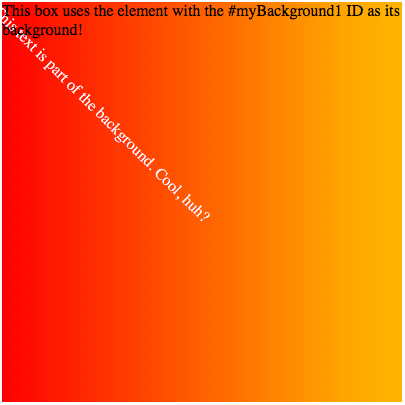This is an experimental technology
Check the Browser compatibility table carefully before using this in production.
The element() CSS function defines an <image> value generated from an arbitrary HTML element. This image is live, meaning that if the HTML element is changed, the CSS properties using the resulting value are automatically updated.
A particularly useful scenario for using this would be to render an image in an HTML <canvas> element, then use that as a background.
On Gecko browsers, you can use the non-standard document.mozSetImageElement() method to change the element being used as the background for a given CSS background element.
Syntax
element(id)
where:
- id
- The ID of an element to use as the background, specified using the HTML attribute #id on the element.
Examples
These examples can be viewed live in builds of Firefox that support -moz-element().
A somewhat realistic example
This example uses a hidden <div> as a background. The background element uses a gradient, but also includes text that is rendered as part of the background.
<div style="width:400px; height:400px; background:-moz-element(#myBackground1) no-repeat;"> <p>This box uses the element with the #myBackground1 ID as its background!</p> </div> <div style="overflow:hidden; height:0;"> <div id="myBackground1" style="width:1024px; height:1024px; background-image: linear-gradient(to right, red, orange, yellow, white);"> <p style="transform-origin:0 0; transform: rotate(45deg); color:white;">This text is part of the background. Cool, huh?</p> </div> </div>
The <div> element with the ID "myBackground1" is used as the background for the content including the paragraph "This box uses the element with the #myBackground1 ID as its background!".

A somewhat more bizarre example
This example uses a hidden <button> element in a repeating pattern as its background. This demonstrates that you can use arbitrary elements as background, but doesn't necessarily demonstrate good design practices.
<div style="width:400px; height:100px; background:-moz-element(#myBackground2);"> </div> <div style="overflow:hidden; height:0;"> <button id="myBackground2" type="button">Evil button!</button> </div>

Specifications
| Specification | Status | Comment |
|---|---|---|
| CSS Images Module Level 4 The definition of 'Using Elements as Images: the element() notation' in that specification. |
Working Draft | Deferred from CSS3 Images. |
Browser compatibility
| Desktop | Mobile | |||||||||||
|---|---|---|---|---|---|---|---|---|---|---|---|---|
element() | Chrome No support No | Edge No support No | Firefox
Full support
57
| IE No support No | Opera No support No | Safari No support No | WebView Android No support No | Chrome Android No support No | Firefox Android
Full support
60
| Opera Android No support No | Safari iOS No support No | Samsung Internet Android No support No |
Legend
- Full support
- Full support
- No support
- No support
- Experimental. Expect behavior to change in the future.
- Experimental. Expect behavior to change in the future.
- See implementation notes.
- See implementation notes.
- Requires a vendor prefix or different name for use.
- Requires a vendor prefix or different name for use.
